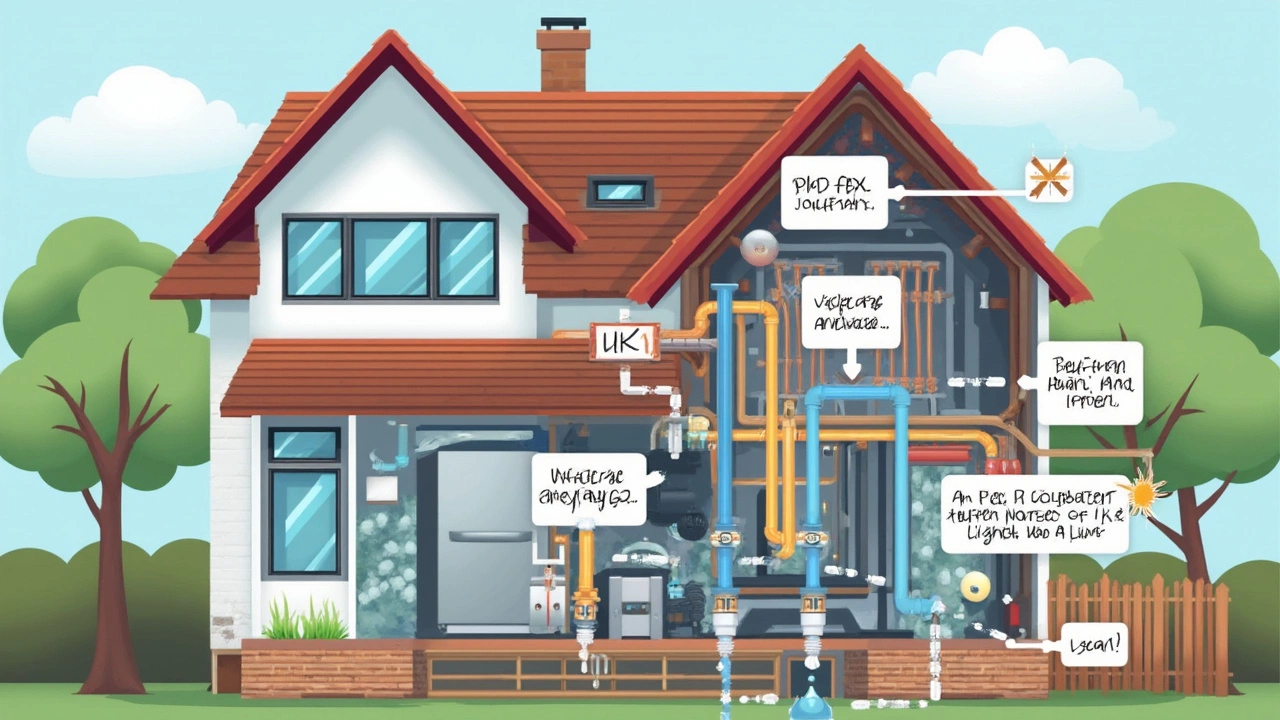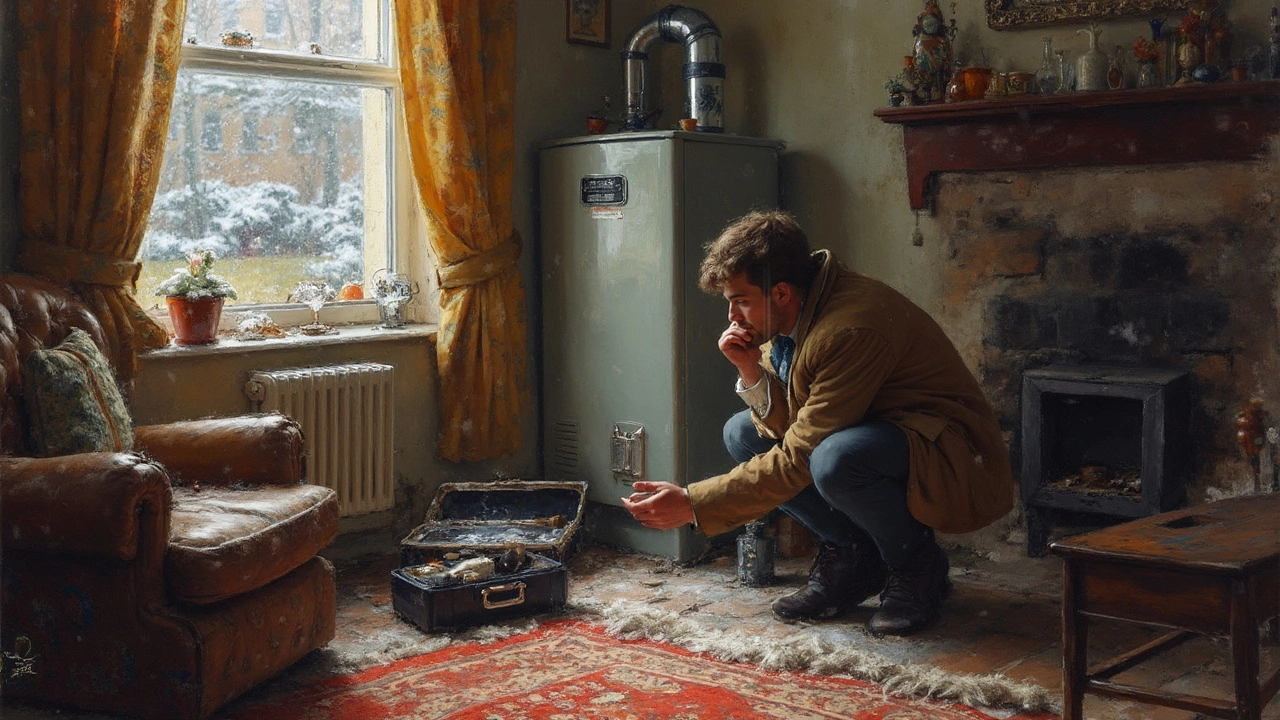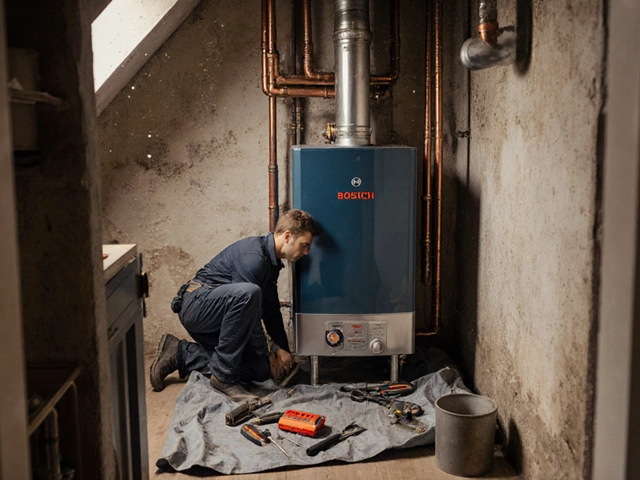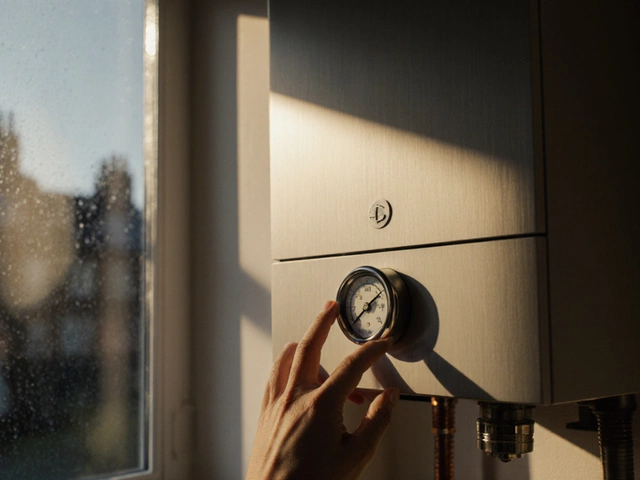Ever stand shivering in your living room, wondering why your boiler's decided to take the day off? You're not alone. Most folks have faced this chilly scenario more times than they'd like to admit. Luckily, some boiler problems are pretty common, and the good news is, you can often tackle them with a bit of know-how.
Let's kick things off with one of the most annoying issues: no heat. If your radiators are as cold as a winter Monday morning, it might be a simple fix. Sometimes, it's just an airlock or a thermostat setting gone off the rails. What's that hissing noise? It’s more than just a spooky soundtrack. Strange noises like banging or whistling can hint at more than a ghost in the machine—often, it's something like trapped air or low water pressure.
Losing pressure might sound like a personal life issue, but in boilers, it just means your system isn't circulating water properly. It's often down to a hidden leak or just the need for a little top-up. Now, spotting actual leaking water around your boiler's a red flag. This might mean a faulty component or seal needs checking.
Lack of Heat
It's a frosty morning, and your home feels more like the Arctic than the cozy haven it should be. If your boiler seems to be working, but there's no heat coming out, don't panic just yet. There are a few usual suspects you can check before calling in the cavalry.
First, take a peek at your boiler's pressure gauge. If it's dropping below one bar, that could be your culprit. Most boilers need a certain pressure level to function properly, usually between 1 and 1.5 bars. Too low, and it might not be able to push heat through the system.
Crank up your thermostat and check if it's set to the right temperature. You'd be surprised how often a nudge of a few degrees is all it takes to kick things into gear. Make sure it's set to 'heat' and that the timer isn't set for some future date when you'll be on holiday.
Still feeling like you're living in an igloo? It might be worth checking the boiler's pilot light if yours has one. A pilot light that's gone out can definitely put a damper on your heating. If you need to relight it, follow your manufacturer's instructions—it often involves holding down a reset button while lighting the flame.
Consider inspecting the radiators themselves. If they're cold at the top and warm at the bottom, air might be trapped inside. A little radiator bleeding could solve the issue. You’ll just need a radiator key and some rags to catch any drips.
Lastly, if you're not seeing even a flicker of improvement, it could be a sign of a more serious issue, like a faulty pump or a broken diverter valve, both of which might need a professional plumber to fix.
Strange Noises
Ever hear your boiler making a racket when it should just be quietly doing its job? Those spooky sounds are more than just annoyance—they’re trying to tell you something. A banging or clunking noise, often called 'kettling,' can be a sign of limescale buildup. If you're living in a hard water area, like many parts of the UK, this could be your boiler's way of complaining about mineral deposits choking its pipes.
Another common culprit for strange noises is air trapped in the system. When air bubbles move through your piping, they can cause a variety of sounds. Luckily, this is usually fixable with a bit of bleeding the radiators. If you hear a whistling sound, it might mean your boiler's a bit stressed due to low water pressure. Checking the pressure gauge on your boiler and topping it up might just keep the whining at bay.
- Boiler repair might be essential if the 'kettling' sound doesn't stop after dealing with the limescale. A power flush could be necessary.
- Always keep an ear out for persistent noises, as they might suggest deeper issues needing professional attention.
- If bleeding radiators and adjusting pressure don't help, consider calling in a pro. It might cost a bit, but it'll save on future repairs.
To give you a clearer idea of how common some of these issues are:
| Noise Type | Possible Cause | Commonality |
|---|---|---|
| Banging/Kettling | Limescale buildup | Frequent in hard water areas |
| Whistling | Low pressure | Moderate |
| Gurgling | Air in the system | Common |
Listening to your boiler can save you headaches and money. Keep your ears open, and don't ignore the signs when your boiler starts talking back.
Loss in Pressure
Losing pressure in your boiler isn't just an irritation—it can really mess with your heating. When your boiler's pressure drops, it usually means the system isn't circulating water like it should, and that just leaves everyone cold. If your boiler’s pressure gauge is pointing below 1 bar, it’s time to roll up your sleeves.
First things first: try checking for leaks. Your boiler should be as bone-dry as a desert. Puddles around it might mean a leak, and that’s sapping your pressure. If you see one, tighten up any visible valves and joints. Also, inspect radiators for any drips.
If you can't spot any obvious leaks, you might just need to repressurize your system. Here’s how:
- Turn off the boiler and wait for it to cool down completely.
- Locate the filling loop, usually a flexible silver pipe with a valve on each end.
- Ensure both ends of the filling loop are securely attached. Open the first valve, then, very slowly, the second one. You'll hear water come through.
- Watch the pressure gauge and aim for about 1 to 1.5 bar. Once there, close both valves securely.
Got the pressure sorted but it keeps dropping? It could mean there’s a problem with the expansion vessel or pressure relief valve—both a tad more complex, so maybe time for a call to a pro if your DIY magic isn’t cutting it.
And here's a nifty tip: if you're always having to top up the water, you might’ve got a bigger secret leak lurking somewhere in the system. Consider a closer look from someone who speaks 'boiler' fluently.

Leaking Water
Finding water pooling around your boiler can be stressful. Leaks can mess up your heating system and might even lead to expensive repairs if left unchecked. So, let's break down what could be going on behind that drip, drip, drip.
There are a few usual suspects when your boiler is leaking water. The first and easiest to spot is a faulty pressure valve. If your boiler’s pressure is too high, this valve is supposed to let off pressure, but sometimes it can leak water instead. Grab a look at your boiler’s pressure gauge to see if it's higher than that magic 1 to 2 bar mark.
"A leaking boiler is often a symptom of a more serious underlying problem. Always address a leak promptly to avoid further damage." – BoilerPro Services
Next up, it might be the pump seal. Over time, these seals can wear out or get damaged, leading to leaks. If you suspect the pump, it might need to be replaced. Something as simple as loose joints could also be at fault, which is a quick and often cost-effective fix.
And don’t forget about the corrosion! Boilers tend to corrode over time, especially if regular maintenance isn't on your to-do list. This corrosion often happens around the pipes and tanks, meaning components might need replacing.
If you're eyeing all the pipes and plastics, check for cracks or splits. Expanding and contracting with varying temperatures can lead to unexpected leaks. Look at your user manual to better understand where these parts are located.
To tackle a leak, get a flashlight and check these parts:
- Pressure Valve and gauge
- Pump seals and connections
- Pipe joints and connections for any looseness
- Any signs of corrosion
- Cracked or split parts
Leaking gets worse over time, so it’s worth calling a professional if you can’t pinpoint or fix the problem yourself. Better safe than sorry, right?
Pilot Light Issues
The pilot light is like the heart of your boiler system. When it goes out, your boiler just won’t work right. The culprit? It could be anything from a strong draft to a faulty thermocouple. This little device is responsible for keeping the pilot light lit by sensing the flame.
First things first—check if the pilot light is actually out. You might need to clear dust or debris that snuffed it out. If it’s still not staying lit, take a closer look at the thermocouple. Sometimes, a gentle clean or adjustment is all that’s needed.
To reignite the pilot light, here’s a handy guide:
- Turn off the gas valve and wait a few minutes.
- Find the “Pilot” setting on the gas valve.
- Use a long lighter or match to relight the pilot while pressing the reset button.
- Hold the button down for 30 seconds once lit to make sure it stays on.
- Release the button and check if the flame remains steady.
If the flame keeps dying out, don’t keep retrying endlessly. It’s best to call a professional if you suspect issues with the thermocouple or gas supply.
Old age can also be a factor; gas boilers generally last around 10-15 years. If you’re constantly having noise problems or the pilot light frequently goes out, it might be time to consider a new boiler. Keeping up with routine boiler maintenance can help prevent these pesky issues from cropping up in the first place.
Thermostat Problems
Think of your thermostat as the brain of your heating system. When it starts acting dodgy, it's no wonder your house feels like the set of Ice Age. Thermostat issues are among the sneakiest yet most common causes of boiler problems. But don't sweat it, understanding the usual culprits can help you get things back on track.
First off, check your settings. Sometimes, the problem's as simple as the timer or temperature settings not being where they ought to be. It’s pretty easy to accidentally nudge the dial while cleaning, or if you have curious kiddos around.
If your settings look good but the house still feels like a fridge, it might be a wiring issue. Old or damaged wires can interrupt the signal between the thermostat and the boiler. This is where a pro might need to step in, as fiddling with wiring can be risky.
Another sneaky issue could be the thermostat's location. Placed in direct sunlight or too close to a heat source, it might think your home is toastier than it really is, ignoring your pleas for heat. Moving your thermostat to a spot with a more consistent room temperature can work wonders.
Modern thermostats are moving into the smart territory these days, giving you control from your phone. If you've got one of these, make sure it’s updated with the latest software. Bugs can affect performance, and sometimes, a simple reset does the trick.
But hey, if all else fails and you're still scratching your head, it might be time to consider of professional inspection. Thermostat issues can hide behind a curtain of confusion, and getting a trained eye on the case can save you from future headaches.




